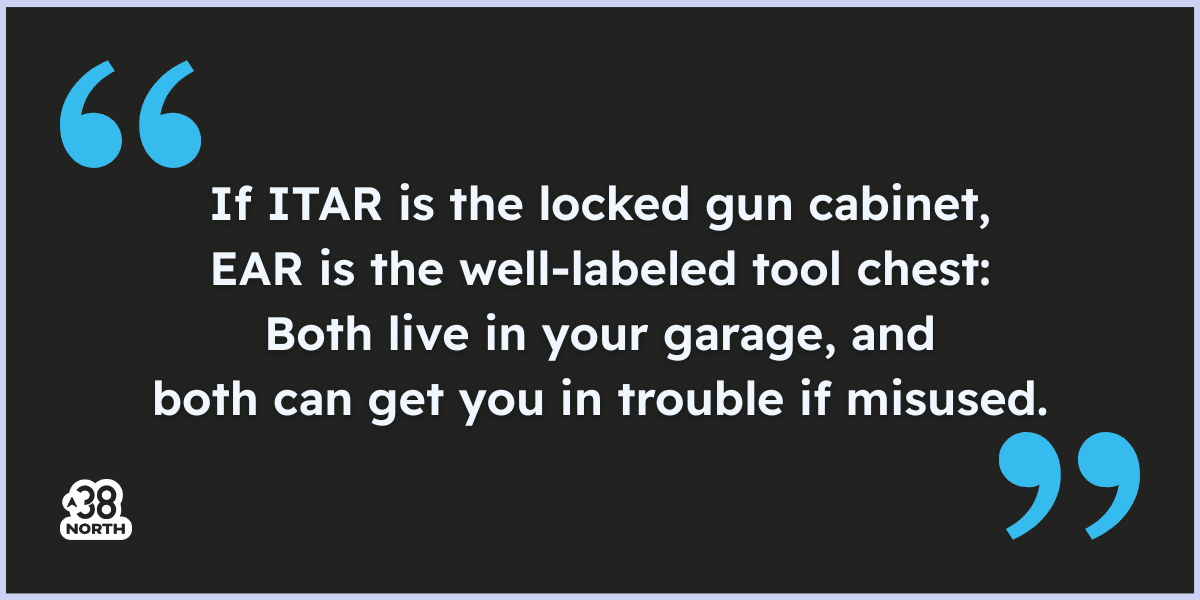Table Of Contents
If you’ve ever found yourself scratching your head over the difference between ITAR and EAR, you’re not alone. These acronyms might sound like the latest indie bands, but they’re actually crucial U.S. regulations governing exports. Let’s break them down in a way that’s as painless as possible.
ITAR: The Locked Gun Cabinet of Defense Exports
ITAR stands for International Traffic in Arms Regulations. Think of it like a locked gun cabinet in your grandfather’s garage. It’s there to keep dangerous items, like military-grade hardware and sensitive blueprints, out of the wrong hands. Though, hopefully those aren’t also in your grandfather’s garage.
Key Points:
- Administered by: U.S. Department of State’s Directorate of Defense Trade Controls (DDTC)
- Covers: Defense articles, services, and technical data listed on the United States Munitions List (USML)
- Access: Generally limited to U.S. persons (citizens or green card holders)
- Licensing: Usually required for export, even emailing a file to a non-U.S. person inside the U.S. can count as an export
If ITAR were a household object, it’d be that old steel cabinet in the garage, bolted shut, labeled “DO NOT TOUCH,” and only accessible with a key you guard.

EAR: The Well-Labeled Tool Chest of Dual-Use Items
EAR stands for Export Administration Regulations. If ITAR is the locked gun cabinet, then EAR is your organized tool chest in the garage, full of gadgets that can be used for good (like fixing the lawnmower) or not-so-good (like dismantling it for “science”).
Key Points:
- Administered by: U.S. Department of Commerce’s Bureau of Industry and Security (BIS)
- Covers: Primarily dual-use items, things with both commercial and military applications
- Access: More flexible than ITAR, with case-by-case licensing depending on the country, the end user, and the item
- Licensing: Sometimes needed, sometimes not, it depends on the ECCN (Export Control Classification Number) and the destination
EAR is like loaning out your power tools. You probably wouldn’t blink at lending your drill to a neighbor. But if they’re planning to ship it overseas and turn it into a missile guidance system… well, you might want to double-check that first. You might also want to move.
ITAR vs. EAR in the Defense Industrial Base (DIB)
ITAR Scenario: Protecting Controlled Technical Data
Imagine you’re part of a small defense contractor working on a project involving advanced missile guidance systems. Your team is developing technical drawings and specifications that fall under the United States Munitions List (USML), making them subject to ITAR regulations.
Compliance Steps:
- Verify Personnel Status
- Implement Access Controls
- Provide Regular ITAR Compliance Training
- Obtain Proper Export Licenses
EAR Scenario: Managing Dual-Use Technology
Your company develops encryption software used in both commercial applications and military communications. This software is classified under the Commerce Control List (CCL) and is subject to EAR regulations.
Compliance Steps:
- Classify the Technology
- Review Presentation Content
- Assess Licensing Requirements
- Educate Staff on EAR Regulations
Ensuring Compliance with ITAR and EAR
To maintain compliance with ITAR and EAR regulations, consider the following best practices:
- Conduct Regular Audits
- Develop a Compliance Program
- Stay Informed of Regulatory Updates
- Provide Ongoing Employee Training
- Consult Legal or Compliance Experts When in Doubt
Penalties and Fines for ITAR and EAR Violations (2020–2024)
When it comes to ITAR and EAR, the government doesn’t just wag a finger and send you on your way. Violations can result in massive fines, criminal charges, and even jail time, yes, real prison, not just “a stern talking-to in a conference room.” To help illustrate the seriousness of non-compliance, here’s a snapshot of enforcement actions taken over the past few years. These are pulled directly from publicly available U.S. government sources, including the Bureau of Industry and Security (BIS) and the Department of State.
| Year | Notable Cases | Penalties | Sources |
|---|---|---|---|
| 2020 | Company A violated EAR by exporting controlled technology without a license. | $1.5 million fine | BIS 2020 Annual Report |
| 2021 | Company B breached ITAR by unauthorized sharing of defense articles. | $2 million fine | BIS Press Release |
| 2022 | Company C failed to comply with EAR encryption controls. | $1 million fine | BIS Annual Report |
| 2023 | Company D exported military-grade equipment without ITAR authorization. | $3 million fine | BIS Press Release |
| 2024 | Company E violated EAR by misclassifying dual-use items. | $2.5 million fine | BIS Press Release |
Final Thoughts: Compliance is No Laughing Matter
While I’ve added a touch of humor to make this topic more approachable, the consequences of non-compliance with ITAR and EAR are serious. Think of it like leaving your front door wide open with a sign saying, ‘Valuables inside, help yourself!’ Just as you’d protect your home, it’s crucial to safeguard sensitive data and technologies.
By understanding the regulations, implementing robust compliance programs, and fostering a culture of awareness, you can help ensure your organization stays on the right side of the law, and out of the headlines.
*Stay vigilant, stay compliant, and remember: When it comes to export controls, it’s better to be safe than sanctioned.*
Need help navigating ITAR, EAR, or other export compliance frameworks? Our experts work with defense contractors, cloud providers, and high-growth tech companies to build compliance strategies that actually scale. Talk to 38North Security about building an export-ready compliance program.





